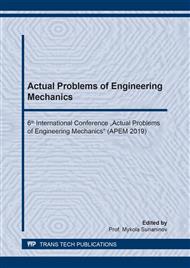[1]
Y. Otrosh, A. Kovaliov, O. Semkiv, I. Rudeshko, V. Diven, Methodology remaining lifetime determination of the building structures, MATEC Web of Conferences. 230 (2018) 02023.
DOI: 10.1051/matecconf/201823002023
Google Scholar
[2]
F. IKhan, S.A Abbasi, An assessment of the likelihood of occurrence, and the damage potential of domino effect (chain of accidents) in a typical cluster of industries, J. Loss Prevention in the Process Industries. 14(4) (2001) 283-306.
DOI: 10.1016/s0950-4230(00)00048-6
Google Scholar
[3]
O. Nekora, V. Slovynsky, S. Pozdieiev, The research of bearing capacity of reinforced concrete beam with use combined experimental-computational method, MATEC Web of Conferences. 116 (2017) 02024,.
DOI: 10.1051/matecconf/201711602024
Google Scholar
[4]
V.M. Roytman, H.J. Pasman, I.E. Lukashevich, The Concept of Evaluation of Building Resistance against combined hazardous Effects Impact-Explosion-Fire, after Aircraft Crash // Fire and Explosion Hazards: Proceedings of the Fourth International Seminar, Londonderry, NI, UK. (2003) 283-293.
Google Scholar
[5]
O. Pettersson, Practical need of scientific material models for structural fire design, Fire Safety J. 13(1) (1988) 1-8.
DOI: 10.1016/0379-7112(88)90027-6
Google Scholar
[6]
E.Q. Spencer, M.M. Shalva, Fire resistance of a damaged steel building frame designed to resist progressive collapse, J. of Performance of Constructed Facilities. 26(4) (2012) 402-409.
DOI: 10.1061/(asce)cf.1943-5509.0000248
Google Scholar
[7]
H.Chen, J.Y. Liew, Explosion and fire analysis of steel frames using mixed element approach, J. Engineering Mechanics. 131(6) (2005) 606–616.
DOI: 10.1061/(asce)0733-9399(2005)131:6(606)
Google Scholar
[8]
A.V. Vasilchenko, T.M. Kovalevskaya, Ognestoykost stalnoy kolonnyi pri kombinirovannom vozdeystvii vzryiv-pozhar,, Problemyi pozharnoy bezopasnosti. 43 (2018) 25-30.
Google Scholar
[9]
E.I. Belenya, V.A. Baldin, Metallicheskie konstrukcii. Obshchij kurs: Uchebnik dlya vuzov, Stroyizdat, Moskow, (1986).
Google Scholar
[10]
I.G. Romanenkov, V.N. Zigern-Korn, Ognestojkost' stroitel'nyh konstrukcij iz effektivnyh materialov, Stroyizdat, Moskow, (1984).
Google Scholar
[11]
V.M. Rojtman, Inzhenernye resheniya po ocenke ognestojkosti proektiruemyh i rekonstruiruemyh zdanij, Associaciya Pozharnaya bezopasnost' i nauka,, Moskow, (2001).
Google Scholar
[12]
D. E. Cagliostro, S.K. Riccitielio, K.J. Clare, Intumescent coating modeling, J. Fire and Flammabie. 2 (1975) 205-291.
Google Scholar
[13]
N.M. Bessonov, T.Yu. Eremina, Yu.N. Dmitrieva, M.V. Krasheninnikova, Raschetnyiy metod opredeleniya predelov ognestoykosti metallokonstruktsiy, pokryityih ognezaschitnyim vspuchivayuschimsya sostavom, Pozharnaya bezopasnost'. 1 (2007) 22-28.
Google Scholar
[14]
A. Vasilchenko, Y. Otrosh, N. Adamenko, E. Doronin, A. Kovaliov, Feature of fire resistance calculation of steel designs with intumescent coating, MATEC Web of Conferences. 230 (2018) 02036.
DOI: 10.1051/matecconf/201823002036
Google Scholar
[15]
A. Kovalov, Y. Otrosh, O. Ostroverkh, O. Hrushovinchuk, O. Savchenko, Fire resistance evaluation of reinforced concrete floors with fire-retardant coating by calculation and experimental method E3S Web of Conferences. 60 (2018) 00003.
DOI: 10.1051/e3sconf/20186000003
Google Scholar


